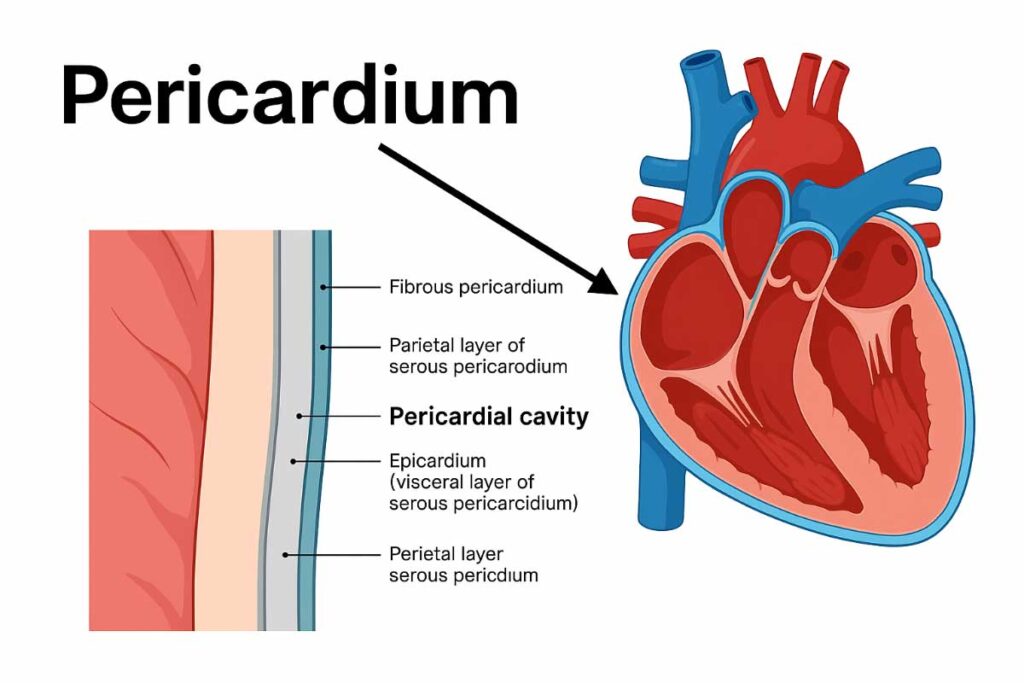In a Hurry? The 60-Second TL;DR
- The pericardium is a thin, two-layered sac that wraps around your heart like a raincoat.
- A teaspoon or two of fluid in the sac lets your heart glide smoothly while it beats.
- Its job list: holds the heart in place, stops sudden over-stretching, cushions knocks, and blocks nearby infections. Source: betterhealth.vic.gov.au
Why I Started Caring About My Own Pericardium
I used to think the heart was just a muscle pumping away on autopilot, until chest pain sent me to urgent care last year. The doctor pulled up an ultrasound, pointed to a black, crescent-shaped ring around my heart, and said, “That’s your pericardial sac.” In that moment I realized the heart has its own bodyguard. Since then I have dived into the science, grabbed every anatomy sketch I could find, and distilled it into friendly language below so you do not have to read a textbook at midnight.
1. Meet the Pericardium: Your Heart’s Two-Layer Raincoat
- Fibrous Pericardium
- Tough outer coat of collagen fibres
- Anchors the heart to the diaphragm and breastbone, limiting sudden stretch. Source: my.clevelandclinic.org
- Serous Pericardium
- Slippery inner lining made of two thin sheets
- Parietal layer clings to the fibrous coat, visceral layer (epicardium) rests directly on the heart muscle
- The slit-like pericardial cavity in between holds 15-50 mL of lubricating fluid. Source: verywellhealth.com
2. What the Sac Actually Does All Day
- Cushioning: Absorbs external jolts when you sprint, sneeze, or take a tumble.
- Lubrication: Fluid keeps the heart walls gliding with each of the roughly 100,000 daily beats.
- Tethering: Ligaments stop the heart from twisting or bouncing in your chest like loose change.
- Stretch Control: Acts as a governor so the heart does not balloon with sudden blood surges.
- Infection Shield: Creates a barrier against lung or oesophageal germs.
3. When Things Go Wrong: Top Four Pericardial Problems
| # | Condition | What Happens | Key Symptoms | First-Line Fix |
|---|---|---|---|---|
| 1 | Acute pericarditis | Sac inflames, often after a viral bug | Sharp chest pain that eases when you lean forward | NSAIDs plus colchicine |
| 2 | Pericardial effusion | Excess fluid pools in the cavity | Shortness of breath, muffled heart sounds | Drain fluid if large |
| 3 | Cardiac tamponade | Fluid pressure crushes the heart pumps | Low blood pressure, jugular vein bulge, faint pulses | Emergency needle or surgery |
| 4 | Constrictive pericarditis | Sac scars into a rigid shell | Swollen ankles, belly bloating, fatigue | Surgical removal of sac |
4. Red-Flag Symptoms You Should Never Ignore
- New, stabbing chest pain that improves when sitting up or leaning forward
- Breathlessness that worsens when lying flat
- Racing heart or unexplained fatigue
- Low-grade fever that lingers after a cold
If any of these ring a bell, phone your doctor the same day or head to the emergency department if the pain feels crushing.
5. How Clinicians Peek Inside the Sac
- Electrocardiogram (ECG) – looks for diffuse ST-segment changes in acute pericarditis
- Transthoracic Echocardiogram – first-choice ultrasound to measure fluid depth
- CT or Cardiac MRI – maps thickening or constriction with high detail
- Pericardiocentesis – a guided needle drains and samples fluid for infection or cancer cells. Source: mayoclinic.org
6. The Treatment Ladder
- Medications: Non-steroidal anti-inflammatories calm pain in most mild cases. If symptoms linger beyond a week, colchicine halves recurrence risk. Steroids, IV immunoglobulin, or biologics follow for stubborn autoimmune causes.
- Procedures: Pericardiocentesis drains life-threatening effusions. Recurrent fluid may need a minimally invasive pericardial window. Thick, calcified constriction often calls for full pericardiectomy. Yes, people live well without the sac, they just need closer cardiology check-ups.
7. Living Day-to-Day with a Temperamental Pericardium
I found an anti-inflammatory diet olive oil, berries, fatty fish, cut my flare-ups in half. Gentle walks kept fitness up without spiking chest pain. A smartwatch ECG app became my early-warning buddy. Always talk to your own clinician before copying my routine, every heart has its quirks.
8. COVID-19 and the Pericardium, What We Know So Far
Large vaccine-safety databases confirm that pericarditis after mRNA shots is rare, about eight cases per million doses. Meanwhile, actual COVID-19 infection poses a higher cardiac risk. The CDC and FDA now require clearer vaccine labels so patients can weigh benefits and risks with real numbers. Source: cdc.gov
9. Frequently Asked Questions
Is the pericardium part of the heart wall?
No. The heart wall has three layers: endocardium, myocardium, and epicardium. The pericardium is a separate sac outside those layers.
How much fluid is too much?
Anything above 50 mL on ultrasound raises eyebrows and above 200 mL can threaten tamponade. Source: my.clevelandclinic.org
Can I exercise with mild pericarditis?
Light walks are fine once pain fades, but avoid intense workouts until cleared by your doctor.
Key Take-Away
Think of the pericardium as a seatbelt, shock absorber, and Teflon lining for your heart all in one. You barely notice it in daily life, yet the minute it misbehaves you will be glad to understand what your doctor is talking about. Bookmark this guide, share it with a friend who has chest pain, and give your hardworking heart protector the respect it deserves.





